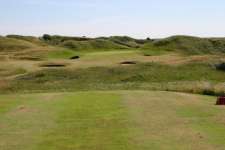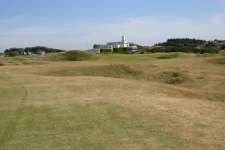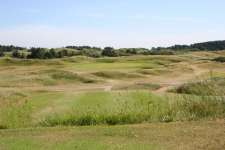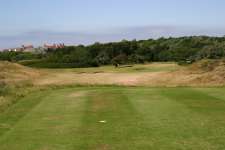First established in 1889, the Royal Birkdale Golf Club moved to the magnificent sandhills of Southport five years later where its George Low designed links managed to exist in relative obscurity for more than thirty years. That was until its site was sold in 1931 to the Southport Corporation who wanted Birkdale to become a championship venue and gave the club a ninety-nine year lease and the encouragement to undertake a grand remodeling of its links. Fred Hawtree and J.H. Taylor were then employed to redesign the course and bring it up to championship standards. The fact that Birkdale has since hosted virtually every major event on the British mainland suggests the pair succeeded spectacularly.
Though the Birkdale site features some of the most impressive dune formations in England, the Hawtree/Taylor design philosophy was to thread the holes through the deep natural valleys running between the sandhills, thus avoiding the need for blind play, bumpy fairways or unfair bounces. Where valleys and flat areas didn’t exist the club even created them, cutting away part of the sandbank to the side of the first green to allow those bailing right to have a view of the flag, and most controversially slicing through a ridge in 1967 to open up the 4th fairway. This hole is now a long and featureless par three but to be fair the club’s plan was to only shave back the top of a dune which extended across the hole and obscured the base of the pin, a misdirected contractor unfortunately removing the whole obstruction.
A number of additional changes were made by Hawtree’s son Fred Jr during the 1960’s. His most significant work was to add the terrific par three 12th hole, which was part of his father’s original plan but not built at the time because of insufficient funds. He also added several hundred yards to the layout by repositioning a couple of greens and tees and advised on the removal of a supposedly great par three at the 17th, incredibly because the club felt a short hole at the end of a tournament was unsuitable. A third generation Hawtree, Fred Jr’s son Martin, later helped the club reshape, resurface and redesign all eighteen greens after the 1991 (British) Open. With targets often cut into clefts against the dunes and shielded from the winds, there are some very attractive green sites here, which thanks to the upgrade are now in superb shape year round.
On course there are few surprises at Birkdale with the holes fair and hazards generally located to the sides of the playing areas and laid out in full view from the tee. The major challenge to par being presented by the length of the holes, the ever-present winds, savage roughs and wild willow scrubs. The links has very few weak moments but only a handful that really get the juices flowing, and most of those coming between the deadly short 7th and the long 13th with its green tucked beneath several large dunes. The best of these central holes is the 9th, a tremendous four across the most undulating fairway on the course, and the previously mentioned 12th, which is played into a narrow green nestled into a rugged dune and guarded by pot bunkers. The majority of the remaining holes are best described as solid, with one common complaint of the layout being that by shying away from attacking the hills the course perhaps lacks a few more standouts and the fun and sportiness that makes seaside golf in Britain so enjoyable. The quality of the only blind and wild hole on the course, the 9th, suggests that such criticism may well be warranted.
Despite the drawbacks, this is an uncomplicated and logical links that most will enjoy playing because good shots are rewarded and straight balls will always find short grass. Widely admired for its fairness, the major attraction of Birkdale, however, is its wonderful setting, excellent greens and the fun of playing such a renowned championship venue.

 this course also has exceptional:
this course also has exceptional:



